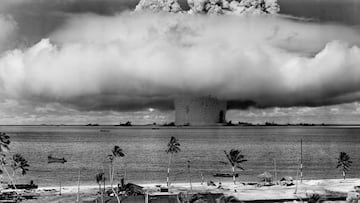SCIENCE
This is what a nuclear explosion would look like when seen from space
Current technology allows us to recreate what the detonations would look like from angles that were previously unthinkable, but the results are as terrifying as they are disparate.

The TV series ‘Oppenheimer’ has reignited interest in the history of the 20th century, particularly in the atomic bomb and nuclear explosions. With the help of technology, we can now explore these topics in greater detail. Below are some videos showing the terrifying effects of nuclear explosions.
The first one is a CGI (computer-generated imagery) video that demonstrates what a nuclear explosion from space would look like. Although it appears natural, this recreation was based on images of the underwater volcano Tonga’s eruption in 2022. If you’re curious, you can find the original images here. However, the video has a fundamental error: it includes sound. In reality, no sound can be heard in space. Nonetheless, the video still generates real terror and is quite similar to what we would experience.
The following text describes a video that has gone viral on social media. The video shows what a nuclear explosion would look like from the viewpoint of a person on the street. Although the visual quality of the video is not perfect, it has gained a lot of popularity, with close to 100,000 likes and 1,000 responses from users who share similar videos on the topic. Although the video may not be worthy of an Oscar, it is still an exciting recreation of what a nuclear explosion could look like from the ground level. After all, if even acclaimed director Christopher Nolan hasn’t been nominated for Best Visual Effects, who are we to judge the quality of this video?
One of the most widely shared responses to a video on social media shows a real nuclear test that took place in the Bikini Atoll area, which is part of the Marshall Islands. The United States conducted 24 nuclear weapon tests in this Micronesian country between 1946 and 1958, during the Cold War arms race that followed World War II.
Although the locals were promised that they would be able to return to their homes after the detonations, Bikini Atoll was ultimately declared unsuitable for human habitation due to soil and water contamination. The agriculture and fishing industries were also affected by the toxic and hazardous conditions. The United States was required to pay $125 million in compensation, even though it had initially pledged to give more than $2 billion to the island’s inhabitants.
And we ended our day with two failed attempts at recreation, both of which were too ambitious in their assertions. The first attempted to show us what nuclear detonations would look like from an airplane, while the second went further and attempted to represent how the Earth would change if a nuclear attack occurred on a global scale. The experiment attempted to calculate who would attack whom, how much the temperature of our planet would drop, the situation of people, and what percentage of people would die due to reasons such as famine.
However, it was a risky experiment of questionable validity, and it was more like a B-movie context. In any case, it is a scenario we hope never becomes a reality. We hope it never becomes a reality.






